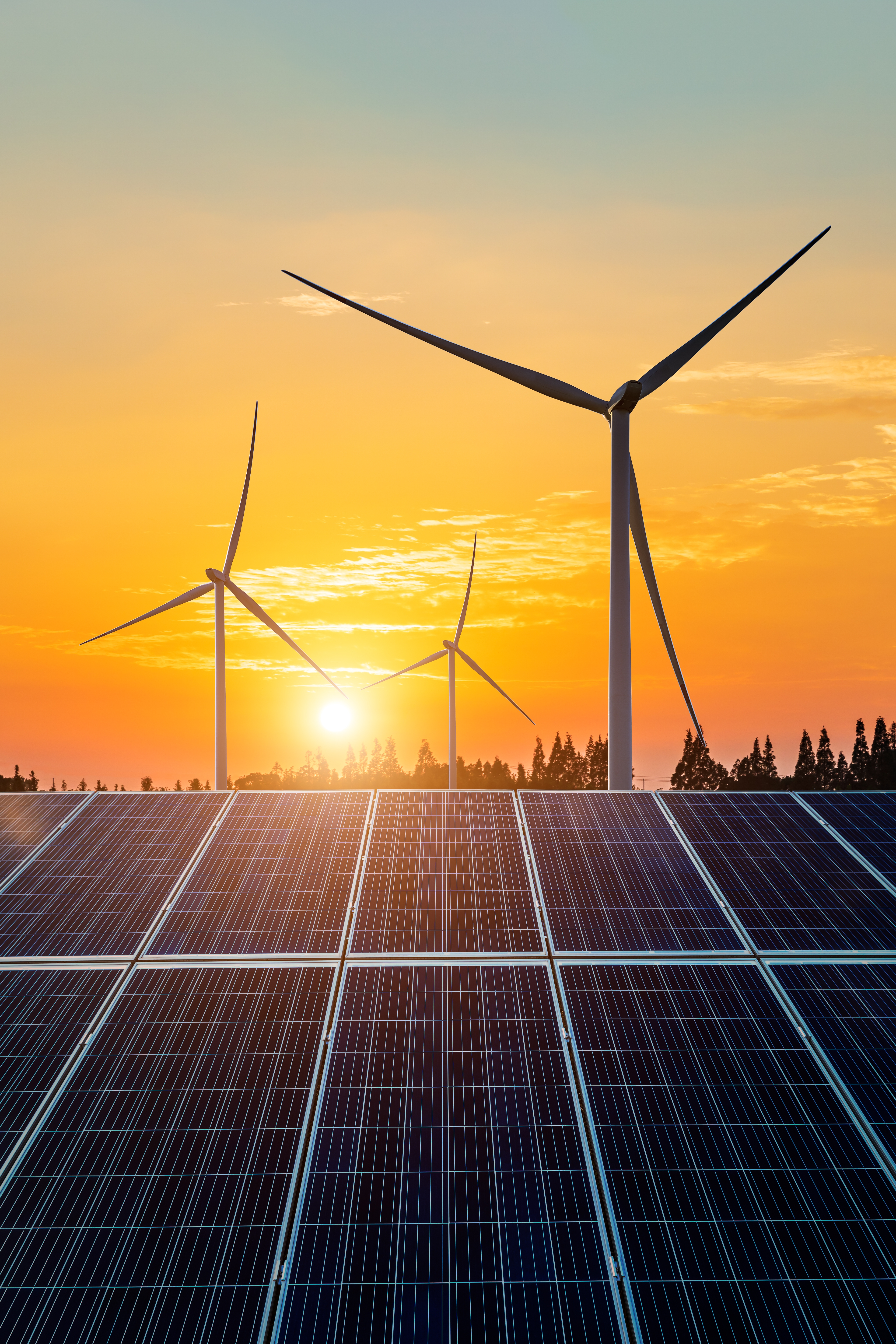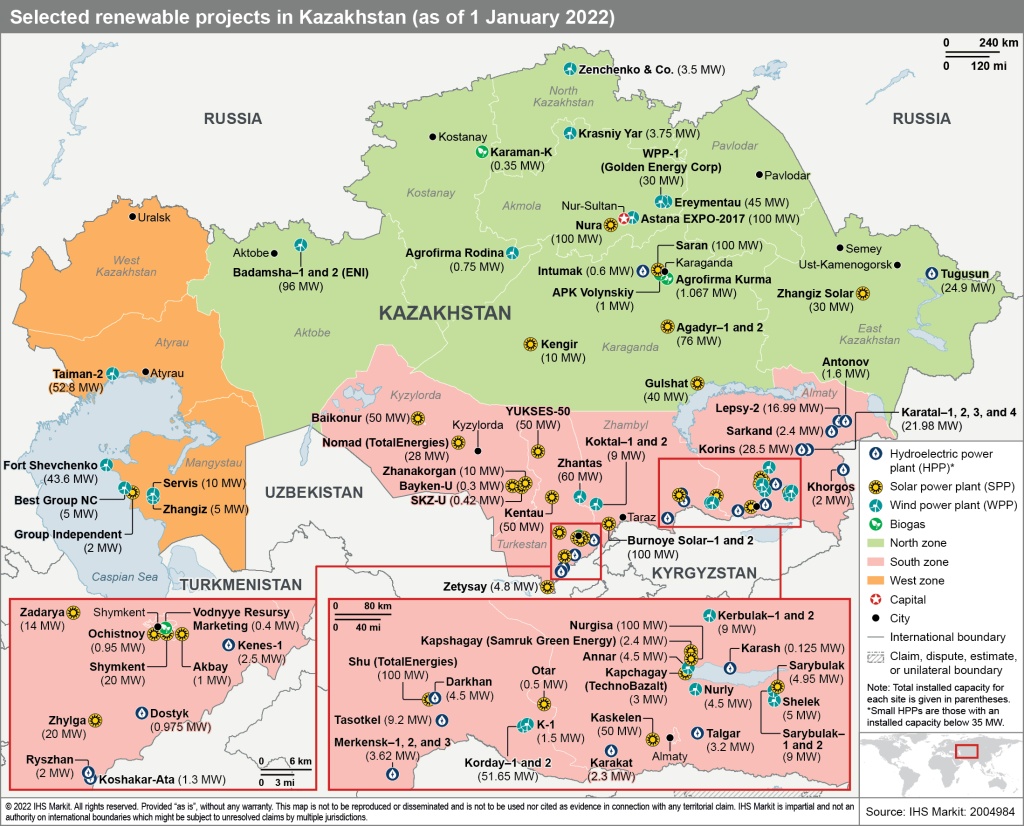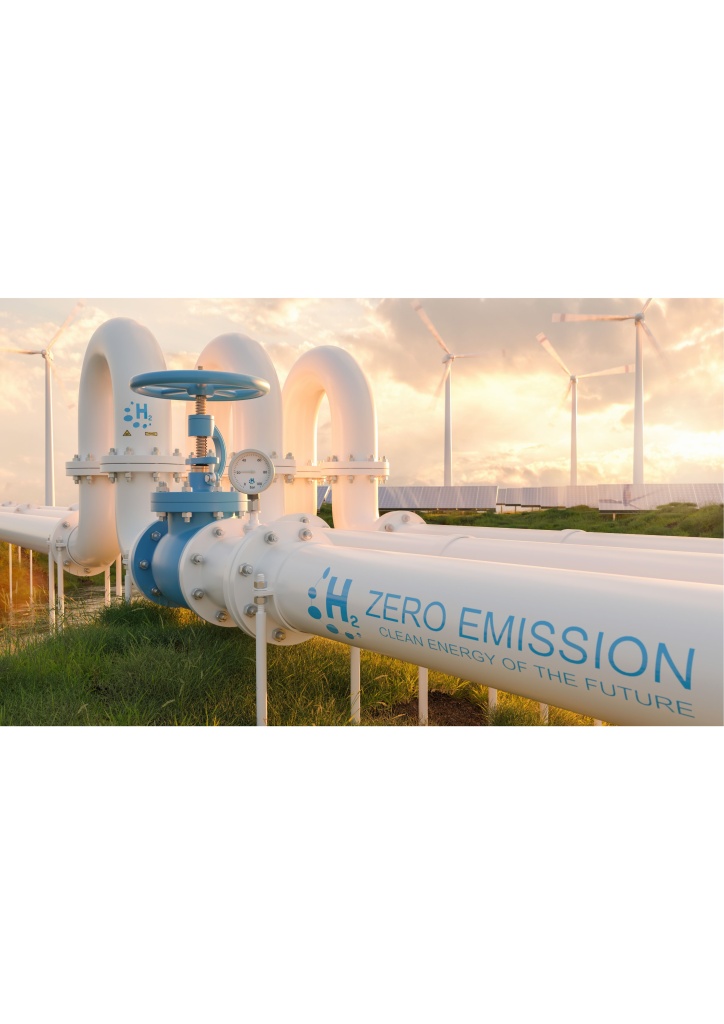Industry News23.12.2023
Ambitious large “green” hydrogen energy project announced for western Kazakhstan

Matthew J. Sagers, Vice President, Eurasian Energy
Andrew Bond, Senior Associate, Eurasian Energy
Dena Sholk, Principal Research Analyst, Eurasian Energy
Paulina Mirenkova, Director, Eurasian Energy
Investment agreement signed for massive “green” energy project in western Kazakhstan
The Kazakh government recently signed an investment agreement with European renewable energy group Svevind for the construction of a hydrogen production project that would rank as one of the world’s five largest. To be located in Mangystau Oblast (a province in western Kazakhstan), the signing took place on 27 October in the Kazakh capital of Astana in the presence of President Kassym-Jomart Tokayev and the President of the European Council, Charles Michel.
Mangystau Oblast currently is one of Kazakhstan’s main hydrocarbon-producing areas (accounting for 20% of national oil production and 5% of national gas production), so the launch of this project could turn western Kazakhstan into a leading source of “clean” energy as well.
Svevind Energy Group has been developing and realizing large-scale onshore wind power projects in Germany, Sweden, and Finland since 1998. It is currently building Europe’s largest onshore wind farm in its native Sweden, aimed at generating 8–12 TWh annually (or 8% of national electricity consumption) when completed, known as the “Markbygden 1101” cluster of wind farms, west of the city of Piteå in northern Sweden. The project surpassed 1,000 MW of operational wind turbines in 2021, with an additional 1,500 MW of wind turbines under construction.
According to Wolfgang Kropp, Svevind’s chief executive, Kazakhstan is well suited to become a “green” hydrogen producer given its abundance of sun and wind, as well as the local skills base derived from its long association with hydrocarbon production. In addition to wind conditions being relatively stable and strong, Mangystau’s arid steppe lands are sparsely populated, offering ample space for wind and solar development. In executing the project, Svevind plans to provide only the initial financing while it seeks to attract long-term investors into the project to finance the estimated capital cost of $40–50 billion. A final investment decision for the project is slated for 2026.
The project will create 3,500 jobs during construction and 1,800 permanent jobs, the Kazakhstan president’s office said. These would undoubtedly be welcome in an area that has long been a hotbed of social and economic disaffection.
Planned production facilities
The project will use wind and photovoltaic generation with a total capacity of up to 40 GW, generating approximately 120 billion kWh of renewable electricity annually. In comparison, total electricity generation in Kazakhstan in 2021 was 114.8 billion kWh from 23.6 GW of installed generating capacity. The electricity will supply an industrial park with a capacity of 20 GW of hydrogen electrolysis, located near the Kuryk port on the Caspian Sea coast (see Figure 1). While the electrolyzers themselves have a relatively small land requirement, significant areas of land are required for the supporting renewables generating installations.
Hyrasia One’s project incorporates a number of features emerging globally that are aimed at reducing costs and improving efficiencies. One of these is an emerging focus on creating large-scale regional hydrogen hubs to achieve economies of scale. Another is the need to achieve high electrolyzer utilization rates through development of a wind and solar hybrid supply structure (as opposed to standalone assets), as this extends the period when electricity generation is available; this is a crucial factor in driving down green hydrogen production costs.
Although this project is essentially autonomous is terms of its power supply, grid connections for these types of projects can nonetheless remain a key factor for green hydrogen project economics.

The reason is that oversizing of renewal capacity (vis-a-vis hydrogen electrolysis) is a typical feature, to drive high electrolyzer utilization rates. But with oversizing, hydrogen projects then often have surplus electricity available for export into the grid at certain periods. This serves as an important additional revenue stream. This aspect is not crucial, but it is important to note that Kazakhstan’s western zone grid is known to not be particularly strong. It does have a large share of Kazakhstan’s gas-fired generating capacity, but is considered to have only limited ability to support additional renewable projects; Kazakhstan’s western zone has the lowest penetration of renewable capacity.
The Caspian Sea will be the source of water for hydrogen electrolysis, following desalinization. The project is said to include the construction and operation of a desalination plant with a capacity of 255,000 m3 of seawater per day (93.075 million m3 per year). But questions surrounding water availability are of paramount importance to Kazakhstan, and the project, and could very well emerge as one of the major obstacles preventing project execution.
Freshwater availability has long been a major problem in Mangystau Oblast. Besides several local desalination plants (e.g., in Aktau, Kalamkas), one of its key sources of fresh water is water piped all the way from the Volga River delta in Russia, a distance of nearly 2,000 km. Reflecting its economic and social importance, the pipeline has been the target of an ongoing refurbishment and modernization program in the last few years (ordered by Kazakhstan’s president) to increase its throughput capacity to over 30 million m3 per year. In 2023, for example, authorities intend to augment fresh water supply with completion of a 18 km water pipeline and water pumping station, financed by a 2.12 billion tenge ($4.7 million) investment by Freedom Holding Corp.8 Despite this, authorities in Mangystau Oblast still anticipate the region’s water deficit will reach 110,000 m3 per day by 2025.
Assuming Svevind’s project will consume about 10 kg of purified water per 1 kg of hydrogen produced (and typical ratios of purified water from ordinary fresh water, and ordinary fresh water from seawater), the project would consume something like 132,000 m3 of saline feedwater annually. Hyrasia One itself has not specified how much water it would need, but it promised to keep “water withdrawal as low as possible” so the sea could be “used sustainably to protect the environment”.
More broadly, it is important to note the general problem of water availability looms large in Kazakhstan. Water supply is increasingly precarious. Although Hyrasia One’s water needs appear modest, it still will have to compete with those of other producers, farmers, and consumers in Mangystau. Caspian Sea water already poses challenges to upstream producers (for waterflood injection and other enhanced recovery techniques) in western Kazakhstan in recent years because of high salt content, particularly as water levels in the Caspian Sea have fallen, reaching historically low levels in recent years. In June 2022, Kazakhstan’s Minister of Ecology, Geology and Subsoil Resources Serikkali Brekeshev warned that the combination of rising water consumption and decreasing inflows from surrounding countries could drive Kazakhstan’s annual water deficit to as much as 23,200 m3. The Ministry’s prognosis is substantially worse than that of the World Bank, which, according to Senate Deputy Akhylbek Kurishbaev, anticipates Kazakhstan’s annual water deficit will amount to 12,000– 15,000 m3 annually by 2030.

Exports and logistics
Hyrasia One indicates that no final decision has been made on specific markets for the hydrogen and therefore export destinations and routes. Svevind believes the hydrogen can find a ready market in Europe or alternatively can be used within Kazakhstan itself to manufacture “green” steel or aluminium. Clearly though, Europe ranks high on the list of potential markets given ambitious plans for hydrogen development
there and the expectation that Europe will account for about 11% of global hydrogen demand by 2030 and 20% by 2040; furthermore, a significant share of demand is expected to be met with imports.12 As noted by Svevind, Hyrasia One could become “a supporting pillar for the hydrogen markets currently emerging in Europe, as well as in Kazakhstan itself and in Asian countries”.
While the European Union probably represents an eager market for green hydrogen as it weans itself off Russian gas, unfortunately the most obvious export routes from Kazakhstan to Europe would be via Russia, and exporting hydrogen by pipe all the way across Kazakhstan and Chinese territory to mainland China’s coastal demand centers makes little economic sense. Given the ongoing war in Ukraine, transit through Russia would seem to be effectively ruled out for the time being. However, alternative routes are possible across the Caspian and through the South Caucasus, but such routes probably would involve several multimodel transfers and the need for considerable new infrastructure. The situation, though, remains fluid and may be entirely different by the time the project actually comes onstream.
Furthermore, importing the necessary equipment for the project will likely be challenging as well with the changed international situation. For example, TCO’s FGP upstream expansion project relied in large part on Russia’s inland waterway system to import large modular components for the megaproject. This transport option may no longer be available following Russia’s invasion of Ukraine, which means the project developer may have to use more costly multimodal options (i.e., transport by rail across Georgia and Azerbaijan, and then by ship or barge across the Caspian Sea to Kazakhstan).
However, the bottom line is that hydrogen is not a very transportable product, owing to the relatively high costs involved for transportation within the overall value chain, and this remains true even if hydrogen is transformed into “green” ammonia for long-distance transportation. Logistically, western Kazakhstan is even more remote from Europe than a Baltic coast manufacturing location in Russia, for example, and lacks direct access to international sea lanes for transport by ship; furthermore, the only existing gas pipelines from the region that could potentially be reconfigured to carry hydrogen cross Russia first. Transport by rail is technically feasible but would be far more expensive than these other options.
Policy support
Another challenge is one that is now dormant: Kazakhstan’s ability to provide meaningful policy support. Creating a supportive environment for the development of hydrogen energy is difficult everywhere (e.g., the United States, Australia, Europe). While Kazakh policymakers have repeatedly articulated support for a “green” transition, and President Tokayev issued a 2060 carbon-neutral strategy in the weeks leading up to the November 2021 COP 26 conference in Glasgow, the 2060 low-carbon strategy has yet to be adopted into law. It technically remains a policy document with no legal force. The country’s policymakers are also still wrestling with challenges associated with integrating renewables into the overall energy balance and implementing Best Available Techniques (BAT) requirements by 2025 as part of the new Ecology Code. There is no doubt officials are keen to welcome Svevind’s investment and expertise, but the ability of institutions to support this forward-looking project with prompt decision making, potential tax concessions, or other practical measures remains to be seen.
IRENA accepting renewable energy project proposals in Central Asia until August 15
Astana to host Electronica Expo Kazakhstan Electronics Exhibition
WB gives rundown of Azerbaijan's green energy grid volume prospects
US solar sets new records as renewables nearly match natural gas – EIA
‘Wings’ on poles: Bill Gates-backed breakthrough wind turbine facility breaks ground
Perovskite tandem solar cell achieves new efficiency record
Kazakhstan and China endorse draft SCO joint statement on sustainable energy development
Innovative research on organic solar cells for space applications
Kazakhstan and Uzbekistan drive green energy progress in Central Asia
KazMunayGas launches pilot green hydrogen project in Atyrau
How private homeowners in Kazakhstan can make money from solar panels
14 countries are investing in Kazakhstan's renewable energy sector through auctions
How green hydrogen could transform Kazakhstan’s energy sector
IKEA offers ready-to-use solar power systems for balconies
Adani commissions India’s first off-grid green hydrogen pilot plant
Tajikistan unveils green energy roadmap at international conference in Dushanbe
Hydropower projects selected through KOREM Auction in Kazakhstan
EU reaches political deal to simplify CBAM
New research could unlock the potential of bladeless wind turbines
Uzbekistan to launch 16 renewable energy facilities by the end of 2025











